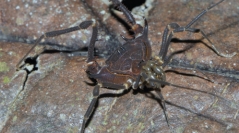

 Zoosystema
44 (9) - Pages 209-225
Zoosystema
44 (9) - Pages 209-225After the type species of Paradiscocyrtus Mello-Leitão, 1927 (Paradiscocyrtus neglectus Mello-Leitão, 1927) was recognized and redescribed, the difference between it and the other two species of the genus proved to be remarkable. Herein, a maximum parsimony phylogenetic analysis with morphological characters (2519 scorings; 28 taxa; 105 characters) was performed under equal and implied weights to test the monophyly of Paradiscocyrtus for the first time. According to the relatively stable results obtained, herein: 1) the transfer of Paradiscocyrtus cerayanus Roewer, 1929 to Discocyrtus Holmberg, 1878 (forming Discocyrtus cerayanus n. comb.) is proposed, and Paradiscocyrtus becomes monotypic (represented only by its type species); 2) the assignment of Paradiscocyrtus trochanteralis Roewer, 1929 (already detected as junior synonym of Bunopachylus orientalis (Roewer, 1913)) to Roeweriinae Carvalho & Kury, 2018 is corroborated; 3) the presence of Paradiscocyrtus in DRMN-group is detected and its relationship with Discocyrtus sensu stricto is discussed. Paradiscocyrtus can be separated from Discocyrtus s. str. by some external characters (as dorsal scutum gamma-type, a pair of finger-phalanx-shaped spines on the scutal area III and coxa IV retrolateral apophysis with the same length as the prolateral) and genital characters (as the stylus of glans slightly dorsally convex). Discocyrtus cerayanus n. comb. is herein redescribed, and its geographic distribution is contested. The meaning of “Ceraya”, assigned to the specimen SMF RII 996/53 (male holotype of Paradiscocyrtus cerayanus), is newly attributed to “Serra do Caraça”, a mountain range in Minas Gerais, Brazil instead of Northeastern Brazilian “Ceará”.
Arachnida, Roeweriinae, Neopachylinae, Pachylinae, Laniatores, new combination